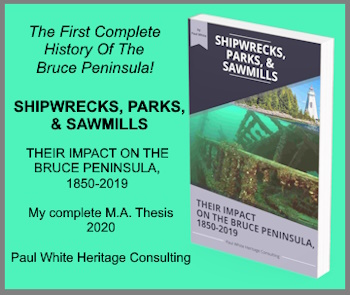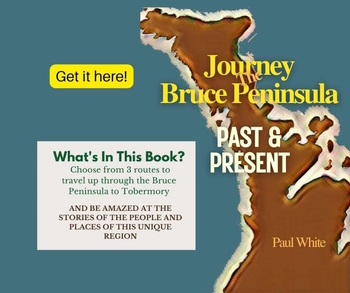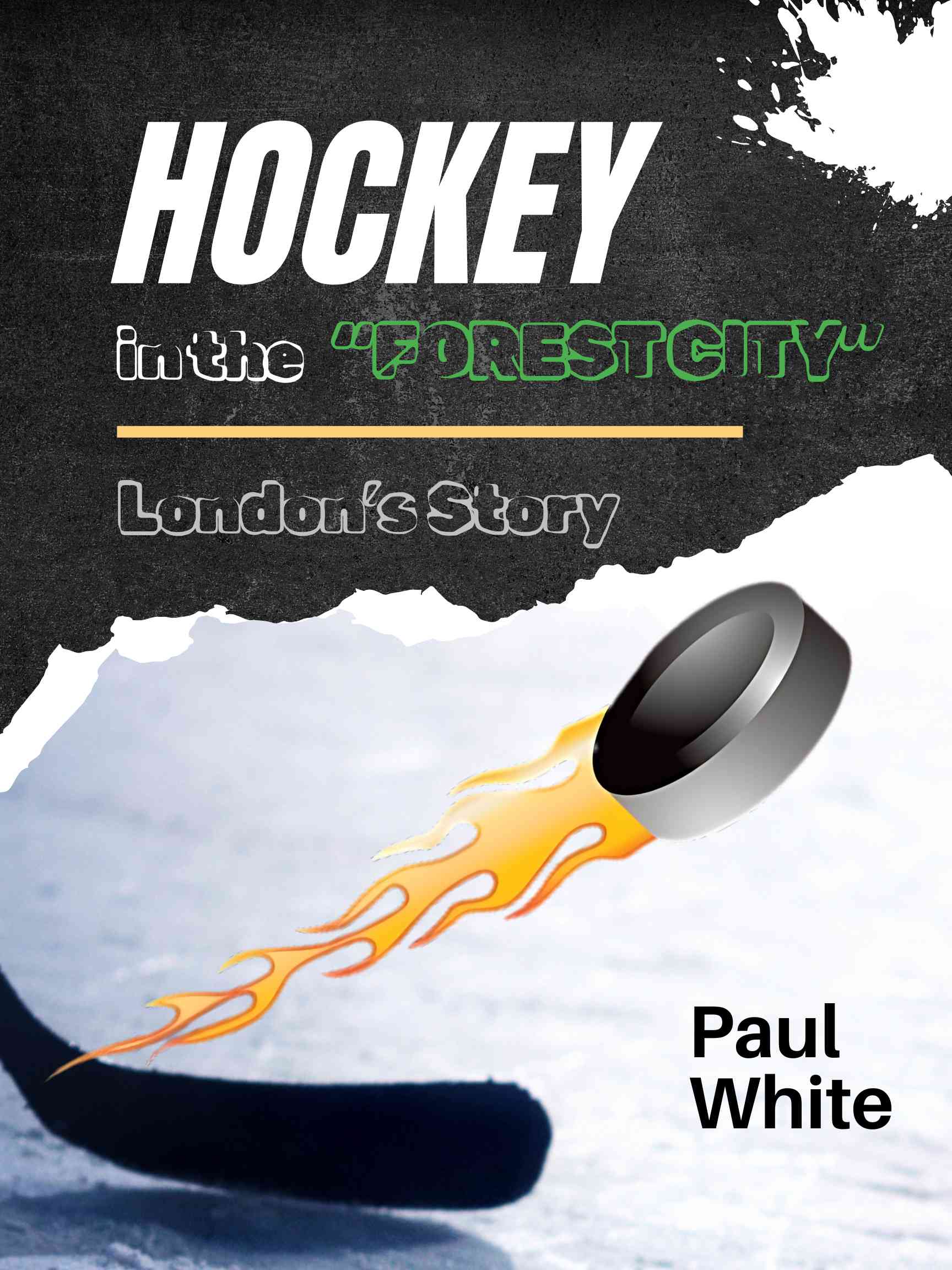Menu
- Home
- Contact
- Books
- Bruce Peninsula
- Georgian Bay
- Hockey
- Owen Sound
- Bruce County
- History Pages
- Aboriginal
- SUBSCRIBE
- SHOP
Please enter the Password.
53616c7465645f5f1a728249816853e843e71c4763965823f5a1ce05f7c948368a86d2e0aa9cf907034467c937066af9cfcdd9be88bf054782d821b76c977c3d141c3ce672b7d4a4da8f07ed541a0a696c62e2dbf8d1a4da3f7ee38c29b59203e2aa078faffdc1b39a2f579c19f0cdfafba15fb05328d49832dacc2ebe56718353c39ac877920365eca91d6a61c06aecfc65ec90ee15f9766f552071a6739d365b3023577f0857226ad89f9a7b1083294438094dd9107f8cd9715cda0925f6a7646f211b8f04ddacf211cbf9a98af683af787c57a2b82c0976119bdba90cc6cfcdbc4d487e96bbb7dfcec6e3461595c7a6577875a540822675df2ab571f01119bc47745d69c4620d04fca684a3675390199fd62f375e4a4deffc8006d137b45d82264e21ea043649126dfa0b349d4d0e209734e107bb7ddb1b98eb561071fd5bb3340d115f458a38374720c2a69311d84a6472b9b57437af2803f35302eb0f77a841148891fce7224d3ab7b2c981d0c5682a6dc3999fee28a71fa5e0d82e9fefa04fe38a7453094f1f1b587bc55bf8b93b12d9aa727b83092f5c180fc4c06213a1a2fd93e0c5b7557bccc3197f3e5237e282d71a88deba857faf16d5e5d60652f00a653e43c36b0a5a2116b240d8a95022879605cf39952f86398ecbef1a02e19b6959c71a1d2aa958957e9d8401f4e87ed6b439df2ead270d6b4ca7971fd5374b5e42f895194654456b055b2a72133d2288df71b0f982320d7bb3d0a92c643fb440d679826f8a61799dddc316df38b16aca1aec7fea762ff71e4ce903b4520abe90f704d2dde3b44ff284f093a4a93fba3c559433b7aa7715cd40e133e86707ba37568ddbbd259f8a52afeec2b002c6b035ab8d111e2ba14a317eba68138232742d3702a912af1fb0cd39d860b38fb17cdd8ce2a7e6c09d7f219135bbe6fde87876e6817f80328fd69039e84cd70945f83644d3bab1a1879e3fd8bb44fc9bfdecbaad64afbfd483f6a2a00beac571c0bf90920632c7308ffefe5d959a5e0d35e46b1e1bb73cd3c6499681facb5cd896f2877219e14a44db563627e6f4fbe9b8395261a7fc842520ac90aaac318fb2096e8fb3efa8cb5cfab49c4fe521c9bea570cd0b0961a9a6816ac1ef3abf9740506f770adf62bbe3b2124035a2522ef54386b6c974d0eba524564cf2fb6b87cb4b9a1cecc90c47f5593c37c9555f8aad1178d13fc11d253c258a4cb278c54548051b786a5c3764fe7ef17ec29e539f69506c2ca89404fd5f3e758fa20f523dcc78a454231b164b3a16602831f6b562b0195b767264707c6b58c93e2eb0527d59dbdb9509dfd33b115bf0084fdcd22823e4af2d0eca72c1b6064fde2e08c9c522b38580e22e65dc082cb779d6833556a4d1b6e7d1e2cf75a67c2277a9fb80ae45efe8ae5b88827df76ecf040b242af79be6d192239989207cab7b33edb640edeffd89657ebdff7ebfa5eaa94a7a35bfa372dfc9de6be18e8876e846d948818f6d1e3bef5237eb5a7f0e2a402488850160dce65f465e24f888053440bbd243fe4790630d4401bf1b88ac08a54265ae32eafd4068a30285a4126af5733b6d865365127fe236ffb3a3fa536333d859d602fd72d875b581007719354864e39fcc6af248cb0fdf8c143cc796339917e8234e1ee438cd23367a48a06c571562029a034116293218c50e932a55810a57799c8a84fd669d94acde26e030e09286d9143e714a3679dc4acc655665a3d5f63c3553170be440b7d057ba965f53d6c141566d59ada6ada8e4c04e795a19659d2aafad5f48754f11ec05f0411ecf906cd5e3a1702582ebd1f362737a790899e939ed3f28e4d30113bbfeb5f9dcf879aba1909644bbba0a5425ac5edcfeac96f403d00d6965f0d515bf71c187b429a9859bf8092941d2fa00fb53624e937905e96c3c09cf24e0ad7aaf8b1625e01fa83e4c293f4b58564e514979c7d6aef20f33e6cb93c2bcba4100a6a4f6eafb4f5d0384a5620af2c25a58f7a48bf04b4849c7237a2b2d5133bd84ccf3a689804b3fd039f71d22508008c56dad8e6bf007d8f4203c40458c1b12e092578ca36e7c6fe929a08b424069fe2a049d3d8d5cd0f216ec7437020a54e3493396caa4b3fc700305c19318131c304efcbb250321a36a6f32e96b419b058b0ccfb34e04489138602bc5b7e16e1a8e288c213d02067e4b84d239a1d049c6f617c9f4417c071fd6c9a9c7d596176ce5e192ace6de9bbc8dac0c5b5a58a3b1beb3177fe4991a8cac3923b2b8e2ce08e85420058d732db85866d7eb5bcadfee428f15ef65f0cd2476aaaeb62e9a0ff85d2c41ae694434beb767c314af1867bf5c77619694886d55e700f4edd4c74e2099946d9ade0a092430332b66a15a2008832161b1c5e58148afbb1a88422a1aff7c2ae0ce557ffbcf055749dd96b741d086ceb0f63d09157ab443ece1f8b4b904dd5fb405aad8dfa5291d93cef3a2bfc83f68358e0b6a8d6bd55967fc885ce32001aae49c360b070cb427a9abae70360b07a4a51af8c4f4b18965d330dd1a20c3c93392ba4867c7657673ae2d005c5e7bd0693d5d3554fa32b08aa07d7dcfb0a69938c4d3d5acfaf1f1d3d2eac2b94404e56e7a224b2b7e7cd5015f658abc57b58e2866cffb98722da6290e82cca23668084df19f461c086afe18cc3f943d4983d6081701b247673ec6f80e0ff9e8a67c96b0f6026a52efe4d2b70b1f01d31f81fc9f8438070595034d64f591f55233bf4c02f57f1c916b800408385d87e38748ced44f900a01107b9ae1b3b6bb3f3ccab5b3e2fcec81b5fc017680b0d52cb602f0920caf5c1b0d0878ef0445b564f581d3ed48d62cf87ba819bcb2c84aef5fe62f6f8dcad0c2c361f2e4608f601033dc208e814415695b812c31ff50be06f405d8d87a2e08856918b988e509f719095a64f93bb2f8c9ef8181406153c7f777ed56dfd5f8ee5cc8b61a8650ba02e4d26b9c944185c7dea8cf30318a55ce419cfa1b79f7329ca5dd0bc3c9755628a1e6cd6d835f2e28aae73f16b339a8c0c46d6454331aad0ab0bc1cea29572c5e3018527285d399d4e0a077aa0c719b6473b3b0883b6987428e0681006d359d252febb78c019b807c139670b38da9b87a2cebc83487fa39b2197452a1af4bf271652191ebae5b92ed383464117b1d3d8b6e72d9362ac61c42df2f62023ab0cd42436afba34bd7abe547fd531229b699f537ce4a3112591b4300cd732cf44524ffc55ab62db501ce923beb120e335beeafab40f36ea20b7ec3fde39ff006d4455c5c30df96457f10b7d2ec2bd1172dd40aa5b7d885c0462afe744736ebb0c59917fe502da1c18a98b2ce1b424ca52b07d58157d71224267e4dbf4f8b8a311fdcbea9a23dc18a4afef106e477363337d7668e329f465219a9dd68495c855659fead9f1e4214174cc40fc8d406fdaff41af762fe5df23358194ed024b7fa2223b6d006ec921ae880a42dbefebd002323951ad3ad51309671b514b194cc4d74005ef14be8fb73cda8794e822c44bd1a66f4d2cf6b96d17e9ecf3e7660cd190e0b5810e6ba200bd5e230d77ab959364bc59de31e36ddcb81236f8c004964087292d2c7b46536522c2e5ad8ea7985670a22d9283c1d32fa17a8006847b1317b7a91ba0b63ee7096aa10ffa76fcae576f4abb5a13e59155f89383882244add0aaf6e886066720e9fc3aaa44b5059bcae98207e3243e29038bc08c4d4a2aa5e783b9a456db8c908dde2f76c6cf59ba8d31b847d4609bd07b6534adaebcbf16f59fd4470731d9d10c0ce065cbabeac51da2100387de40abd58b5057ef2b1e16cfd2bcbf93e7d54be5a0b851bcf399ddc71f87bc0c75066d9b3e73b13db9fbabc7e4095b5d9fcc8ebf9c131934c2f8d4c1403379c34940745490177f439fcbcd3da7b2fcf2fa75881ccb19127523080e5d1d533083ddb8c2fad2b8e00683d5707fa5a2f1dffd6bfe915433d46fd51ae741b83505ec62d5550bb64597e9dfc80f4553118242a191a81ef104b832c09997181e8c171d399a0f3c9bf0475ca00c944b0c3d18a34d1006af54e74408f76700334042f6c48936aaafabb8a632d3339f9b5c6079219bbe3db61936cf78085db6f4177460c427ae0d7189083dfdc53135b86dbd1fbff4222cf2789e406b738f51f3b7c3df5470cc54b34809a0d5fcfbd9c34d890681621d8fa0d2a4a8e4505d5b4c9645359f99c8063422a9ca577d70c9cb541d9ce8126ece47dff7f77c2854751c233feb5032a2a8e2bd771aa99469f2e894735baffb6c84704b32f5a14cdbd22855f075209e1985f7bb978b42f649131e08ff908fe30d375877bbcef5fb339f78fecffa3be7135d87e79327a123e51068d1bb06d98d3399a0c4d1106b2358d0c7b546d3b9b4f5f3f675309ccf9b50d0a2355af892eed6fa698b298886a3df7cd986bc0addb8973d30adec1182ef7edff17f9b6922a8bfb546eb4f7030d70a579059e50e48eb7aebe13816b69196154d8ea2f37a50baf4ca9a92e79ca05293a46a103f9043fddb8b5534923ce84ea82834c0d5b430adbd5fdcc7693a8df2580425fcd4dcc2525f78b2b2be92a00b1a0c9953d5e4bf446371e5314c15b8cee6e0bbef05a9489faab8c0bcfdded0b7dc8876457b39ac04a9862c0eef5010086c7cd73612fd4bf08e984b90fc7de2965e02b652d2d6924b4448c8b05b88f10b69d0e27662d929e2e92b681c7489ec8d7106ac25d0642db2a6c10c0c9cf2a3e9f3d83fb45988722774dd6ab2ba94e5102822dd57fc6f4145fd5ead07322713768cda1f587b2d789b554cd0a9edbcb54df343c59608d28e7768ffbe674f0e65aed0cd08e15aee97c7b6d0d598b481f1b316470b7eb13fa1942c10477489bb73322b00831648258b35a8bf9f9c9b42936a0f2c1bf5b24a72015293114930c8a07afe6dc2acdf43a9a1c5424206931e008fc8d92c9a69308277e79e15f9a5b407132de1f3a2b0b4d042852895984823d0105dce558934491d22116beed86245e4d641b63c0c5108edfcbfdae5abfc74a7aaaef9253f05c3fdae39ab1d1483093155ecde852f3d70eba2c309df7a9fade4182ae9c8115d7a9ab978212a6bcff006b8fff7c7cb2a57e9938c3ab539ce4124302f9ef4162632369c96d557ce9d7ecef21caf2afb07b0c37eab41a12f3d6654af86517d2a75a4e1dabd16df36f914dc3ba8dd2205ae801ce96f02bdd99aff5381d942b775a4a4dd1d2ef680143838f2d1051f2150816d97957760fd69963db9b521a1e0efa1e4d44426411c5de6d549edc5eba6faaa3c8c8c711f17452771e6a217c742d6c2cbb47921905af4b6c25feeac10f29cb7da68573c6ea554d5cb679f8f2f64e3821aa55c714c74fbfcb7319576e7a761b29e7ec03b25866c84bf7c264c55e4aa36c7186fd78cf66536a3c1987a678630cc966c7fd29c55af49d44d778c50341578d00c3de36240b948025b156c1ced3266cdf2a0f335b6ab8f4905ce7547145309c6158fc50b9696338caa4527f11e8cd3177a1d4c8c9b68f20dc42499ec0ac392ef9171f2eb22bd379fd392f6f488771635fff2116d9fff51d5c21c33e335f9ccc748ffa73cd5679e51e4b85dd84b9e87e9921e62d270e1952d6c96a9828c437568f217bed2464f63c18c277a90c17a7f13847a63e8ff160045d35de8f2232ea40bb5e0edbd11ab9377d57a660fefd9db52b58d8e5e863567b731ed82073a3b0b05f0951dc0c5112dedf7541e7f95cdc837c2a792444347ad3fadf48d3ab13d442d62380e5bb210f4f7d74356af24f14e871f7e387c97b7eb920ae3aee708ef048a6e48100a143f8766f2c2bfaf4aa70f0f16e25c68a99e3d839877d4f18790570b79110227791b43f63530d3c1bb8165d011364f8cae2cf0442b30f562704ac5e16537ab087f8baf53662afd41ad5f3027ef3202e1e3d527ab05590d896085be0de222fa398069f8608679d36dd7e6450affc58b536b18631accf7e484ed20f6d1773531a1e5aff9019577a3b7f7836ddfe827edb6378df5949abde0baf5ccbb41eca780eefb5448e9c321806b1e5e6a52a6ed5148f19ebc7c219bf3566bf7d33ad5ba01d3d041f1e1bf8706b9633682f0dd4572f4848e97ee5a81e0dae140ff500595e0f5929c3a69d17ccd1a8a4d03c96eddb02e58a97bd23d40af292f15e285cd5151676b6977ebf847bb86efbdab9e60f51b3ca9777abc4020cf6303987d4d1e61caf00193ddfdbbe16e6e46f0e5ab8b4877f68be1e1e84bed038171c70997dbeed3106a05a65be01e3cdf5a89d644b81817e917294472dbee181415259dc790d6370c2877d0b9a2c1074a6bd1748316eb17df653d0c22c887bff83f8da1566f51ce83a5aa91865aef869f03ce42886a2a35e1505c9f24ced9621cf8d87e071f4a1705ac7afdf614338d72dde5e10c1c3796a81fa20a50a1d32cd471a28c6ff4f4a972d0869130658b1aedefb246638ea7551169aa3a7d514fcd24dd968e0e5768119d6fcf3b7dd88e37551caa06cfef56e9b58ca163eee19eaf19af33089701cdfe2600c1757132ffc51e555471164c2b2980f911e128a6b3d8d5ab83d78f259bf44bd9c2241d60b2ab04129bef53baad6f2208b7700681f60dd7a8603f3b7bb2891d0701de701e1aa7067fdfecbdc510c390c622447ad8717ccde069ee04e5f0201e2259627e4f04127bb0019268eb7459ee21b1d89b79c38f8ddcef2e248d57bb691e4c798d8df3e94fe57196fc9697727178b40632b48575a58f1fc2f2480502375538b0450bc6b8a99969da0bca295c46b75c73cef6e6bbd7b6339dc5eea79ae8d3552022b7d96647cf2a1d31306a5364057787a74ebf1cbcc664559c23dd7bd85dec17113e710d37c85382cb09a95f61c5658cabe51583a0ef5552707a332a6a5dc3c17afcb7af46084416f6669ba92cff9d04483f65bf0ceae331f58d9a2796c764fa677da44bfa1909592bfac40c795155f41086f54a7e700e58bd0e1d15565adf1e471a5438e2c2ed541c1b1501d8dff51db7e627f8d65fc0239c2d458a676679f65283d5291d874c81190c6be13d0048e498b8f24162d2caceb658f738b0c2fed64361f733a1f71684dc74051dbd2bfeeee826bb3a2dccd0b56da60cccaf5dac12aa785dbff51c25a3fb2b4deb78c7667cd2891726cb356b460f07611fc9750bf56cf65767d93ed1a79e291f13fd616a9f2bfab0f7a14384bd5f652604ee562fc3a4309420e592911baa2024d523ea7953aca77986c74c90bf51d49217361d07b65577732cf0e4a9e6848a07a5f076c69fb73beca9aca8e8646168f8a031dbf2a1ab33c3da6d467535a7990123fb7b1d65b49c0d37965e2db9e869b3fdcb5857723a7c710297526d6d3f795a8c0a194fe27d2f9a3118d23b7505a30979a27eab51e4db6681ddd36e946de3fe021f4ca51889a4096b89052ebc8ec1092766a1078ce25416caa785684f732107da6483a931f1271179fd68720cb4d14cc6f1da84606593a36a38d8cf1f7f30cbd56befbee9a97b5169bed1766cc9c909b68ab80c38ca4fc99e354b09bad8b8c2b43f2181e5bb8f645d0cb598cb17182c304e94c1fae492e2e875d1e825ac52522271cbf5390a1c393ce79bdb351443746e5e03a3a8f2137da037cc0ca8e8305d6e3e882b0cfb14dccb40a2874a6a1203ea784ed2c359b3ac524bb2c1d0bf86e804789a91834a5a654999ae33d480a35bd60b337359c692a8e339aa2025c03185d263e5274f0b7a8f4015df448a4f15a20ed43835963ea46355712909a813cf40e81d3e4ed0ac37b22b0e3fa2cd73e771b5d0e8d657b597b2f3b63e3b56b3bc0f001ec757cfbf6402498330f1b1e63c5c83d21675b712c529f65119f3ff6ccbac63105385c88e5cdf21a94a56edc7b34db3306465b0869fa7e46786ff71399556a327cec4c7f2ec0f3e9b6a645e6aaa15ddb4a3bae95a15a609c7fcdfe7c6103575101a03ff25b92220d6a3391f5faf2ed363c6804d43e7a83b1ec96a9e28cb094010990533735615e22373f90fe8d9a83ab546614167c30fed596d6b3f57075a1bd1235742c7eb4c3c301f989933c74df0bbcdbb0d71d1f9f1f1cbdc789d957c811e61f872312ec6030dbdfd3424c1043103a971749b5fde547da7dcafba8ce89ba2522e4ff748e9e4aa661b2d610dae483cd874c113f63e44416c17256010ea4c6cc54abbbd09bd45cdd8e15ad6cb3b0aacc7ac180b88758fd75997727f2cd4a47964fa41c3bfb84a021d1e003bdd4aba140386a36b7f4931f039c2e400978a34c4d2b0cd251bbaf6800353eb6519a409aba136a213851d0a11f11c2726572f66c1b0c90b0b53d2ce6de6153fb84f2357cdbf6d21dd583f9279e5dfbbf425d86a3cfc54e67aa416a38e828d2a1e6220f4d6b1a0dda49f3e38bc3426ae492728421ac21dd166da975b1a087c5d44618e83228dbf8b95651a96e46fcbe719c73cabf3015e7bd3377d5e8b22c0b15e2541527fa3992439dc246699629f509db3921034a709a7cfaff27333bf383df20c9492a669afd5e5eded835fc3a99458a503c2bd17cc523eaf4f8edc091633dc53b0cb3b2f2d82917120b0bc9a0dc16ddb06efaaf4f8eb77b7d825c7205a7420d513e5090f28043e3864f5c05a516734ccc8d24526cf2d9bdd768e822e5e286dcda910855fc68b5208565640e103f24e38045db2b26e3556819b453747ca81ec89af4f25a466b9d6b04aa89dba23cf14a7bf9108fafcce4c10c30a83ddd20d3c02149d5ac55c912c3d15f064a55b464a750540e54377a5126cfc499901cb92af029fd1f8d24c1a974295074facde3575743caf7df9fd8f76591e79963fa0423fa6fa2fa2937698e29054ff26a19fb6dc9997fd0d5dfe0e62625ff0e2f020b14ed5038cc3bf2aab06665142b6049c98868d310b7d730f34b594cb9d6596dd45e6c8f0f0f7f79b34778cddc2460ca49a514e561d0504704666c2795c45b7c19739d697604ca327516fc0e40c8e2035121f0b96e420f23fba87a6d4cb5707b24f0299650fdc5b37401ee6e79cd59164d4cc8a1665fdc16cadc29eb31407af67bf413c80c08c56153fdf622fad817ed8355d3a7e3d795007a33a4e9454032cd82995b5bec9c90586c3ca399abf91e7306280fd2d3c6ba53a54093f381fd99607947a80f3581a954923614054a5bb4670e58d6caa2f03bf52558eb1132b84f81abe35ed46f77b3afda242e2ed4c7208e35c69308641bbe38592bcaa59738c802a50d3f52baf53a440d0ba1056d5950d0e0e5cc9009d4ad67881cb046aed425b5a66566ffb6c43cc6bf656f88e335fcd623526f5000ede75cb5ba61e17c3502d6ba3c999963602ea25590009681c01a64c8f499c5dba01bf704b5aec7e0f70f0e75ba2c9fef9d1a6a3c993033e429880535324a7c039169a2590722d064571db1b6e5316cf2043b41ed4238bdbfdb2f8ade15891851ae0d6a7700f8928855ee7b68f16de749768690ff6fd695f52db4463ef18c52077a0c3f3a9747890fd3b7dbf5e405167b5fae5807a80618771d845e2cc0327b9270d9ef434588657bbb22a9d9b1513037dcc206f8101438138aec4084a336c6ee7a67f1c3ebf9e9148b9f2dd1d7c8fbe36c8235134a3bcf49f6990bc162d5d9a9a137992e1164654b9dce4cfc7dc6f18c3fec2d9c324d25615e05a802a5f9468f68aa334f47f0b8699e922da3fa218d2f21cde9644c2a38550271ae766f796c518546b4917fe6cf2ad8f8a5ed855ac42c9e561737981aabbf9b983fc1680de393120b4d93af29b208ccf1ca70bb4e355dfdb67488c380b3ae4e297ed8bf30104cb05bc422c3901fb0c70b22922eb1a16339387078f0fac9ed7e3b5768e928631c5a42e6e8c73fd7bbe5ab4076b5d1f5bb2651cad88e39dbcbd18d345b8188f384bc56d5a29c48dc2eb926b862dfc9571a252ae8c0642520483fde3188c3c74813ad1a26c3d06c09c33decce6384e07136809980ac7d1d8905b6ba948bc6cdb77060f6e603d91c79e2c5c98606b58f011fd5b24174c4302094953944dc78d3211966a406f4cf1cfcda097f9a84d4ebd55220d653c0b2f5213327e0271cf9d586a6b33056fdac94d7199cdd7862a63ab822b19fec46406fada6de230b77d227acb058717d0285f7c91f7153cc1e7749ee147f26dbaf1aa3cef828c9f4b6463c4f187a9480c7eaddbeabbeef6b2630b4fcf4a0892151cdfa294e384b698b460436ec7a791ebacd4f57a00211610980aebcf9b4d4825ea2396987340773b0f82a06848be4fd5534d5dadc51f9af5b75502f3fb2ed35f1541b1309ec66829fea3fb715ea8ee0ef061377d42882f56274140603a1895d2015e8401b39d3b4daadcf2d3736313039abb0d6b10ba4007e4315ea1c6b77f3246c070124c38599762185be2e42890f1276fcb06dbeb53e3ad08688fe290679754cc7c356693090d57a865325f752cf2314368e939c4a6c599a06bad1effef225046da54c65c5cac2874c079f0473ad38781b2379e6c54ef6ecf67938fad2360186c0759e026caf6380060a4789d0604e8f797ebce935e3db07bc3673c7cb6e355baa18d5534c143df445402a92549f733c35606dd93cf9e39ace82695e8fc9705c6c11f64b1890e110faec7ac60d0796a99d4b0ff6968c7b234d38afe7682c1a9368560e4d153744c51c726b460dae807db1a55848162f0e35d2d5df79a4ce8c3d4e15ed960dbe32336c82b2e5eee8851f653f3590c60fd49c9b194ca4062c4ef3fb896941aed1464f83a893ad9b2207e7225a7bb6f6b98970e27da012c8d8938fa8ac209e4c942c6d0fce8e047168371a6acba2423d68db6095758c317f3dd557ffb33cfbb77af41289e66daa51c950580222a33499c10ae1a61d176604daed85b44eddaf770996375a225066e25b3a5697fad9a1677daa5a8b3d5c16fe71a29605a975f773f4ba7ddec66878982bac1af54e1432a287fef1e17be6d4a05146791d4f008bed93639bea998a459c17b37a9cf8e06b2d822c921960617e7accbcd0d4167d4d073890e0a44dcec66bf65628dec18526f1e0a7dadb369ed4de129b8eac4120a4179ae8613eda7d299f493e6ffb3bacf6b9373a429971a914213c3130d4f74756da7f9e6786ef8fea2a5f5b7b3fa29aa4bfeb6c8c1713e00685600811f83dae9a225a49fda605671e67ca5c5e18ec2cc48b5e819b3fa278e0aa805956dc7b5e7625566603909890ebf6aaa39913e7c8560f1821e8a356babebf6ac124350f6044f9d60f37fd68f9a29d18517c92a91bfa7b3b4f0bc08b78f0e3219c3d9d13f56625f96a86dd7e5ced01d7ac17d42c69f15a53a7f85d672b58506283b77413ed58b0479b85b25527901019aa5cd35f2858d59f13b652439befca9e25fd698c2ec3c7f0f0a001c7727e26abcfb466d4783202801fb0779e2cbdb017615de2c57a98c17de1e6e4b07fdae905d465306a2f03af56da1a55953ca43ef1c2b8081d63c48e2f2bedd27f1e414e915f5250e8a1b05097809389f4cf9540c0c6908d55839415b0fc3e28b4eb457f91b9d558ab5572da9b22bbdaa2b9069e8438e3ad8b0613c37c8c304e71967ebe34a429ac68794e630de46fc7685297e4770724f54c7c6a57e55c7c92ec9ffc434b7ecc3a8d0abcf73a08b9bcb6faa8a39bcd3a8c6e94e4db400a4166d12fd3400da9f575d6aabae0bf5267828ea97e02acd43c43261b9c1f1f17909fb36918ec4b29f635cc45928c56b84527de058f150c6bed632ed3980e396ee06853cc2dac31301d9f946e81c43c4b75794ed3c12aef9662b38aa5470c67e52eb29e00ef54270d7570a8b97df3ac2e9d83b6360925907fa2874d80d49f998b04c1390f8cedb4eb59305a09773b66c7a533d8d142a6d8c2616b25a947f24eb468ba54ebca629454bfec075d78e3d2704970b49ce03cd344c257f18ef976b2a147ceabaa130c5ed65cdae017a9919f7d8c8a9747a879937b2cb5dd521a0f270073fa559b528fa9020bebcc1f803e3d051935f6cc2d3bbf3aeb0dfa2c495da9080f451b94e38829a8172f3f01696b7d0be382886ec05bd0ff495036cae6223995caabf0a89cefcd0de20c03a2e630aa8aee750b7a46b43b5c35f08a284a05f65825fc3c268496e2e9c751ff09529245ee89d92b2ec142a6d188dd3f04c25242be1c93afbf447b7eea06f1af61d21d18231a15668e74a45bebd0877a6447fed3fe7852bccc6ccb7d671790fcfac8ac0efb11a6caa25f0d6e61c895c19417e22230c4296e1f8a6f200e4aee610942dba7c026c1bb1b4d88efbee7f5e395c49cdc6fadb0eae9621a4dffadfe6c5a88eed8e7382ae9fbd3b1c238b51c06dab6d40f22a86447220f686f986cac65748884a3b76ce2fd81c78bfede037bbfd7ce03966658ed57d93e60c3d9587c1613b3a19f5a1623903b2fb22a298d396ae58dcd810275bbc568fb2d16554766cd03d7ba83b536f6644d69c9a6fe893be80a87e0585590393f09cdc55723d58f0f4e66f45d00d92110757d4f4fbd612db80a073d89a536f442ad3d43d71799a09d219d4418996c853cb37adb790b5673f9dda7adb0141ec506b777a7a80e1351bcc6bbd24e76c89ec04ccb746c41616409624331963b6daaa48a3aba404036ea43b1989b980475350f50d9d46bcc1171e98b6c1efe871faed55f1b78dadd97e7a1c786d6b15bbeed8e7342fe051312a60f46f95e34ea40f4f6e4db5c3d6dd0b09f95103e4b774fb7408a9eb85c3d2a2a750102d7246c1596c1a3f5574f6ab88f9d4978ad417df2b68fc2b9a20e11de996638e34b965b76c842dfd099ec0b367a0fa5f141eb33c44a3b35eec6d61a0191ebd7227510bf7844bde7f6c3d4b4677be5d70fdfff2282e708caf6e0954b5b16fbd27c6e5e67efd9d5ed936cd6f38e87679d0e373beb35bc5bb1faba67061572101656344ac182c9dc309399af5a51f6378f1015580c0ee50453e9c64a5cf9f7dad999a09f50d1eed0262661a2e831b09930eb2f79088cb7eec789c4d0d1c01b3a72731d01a10e76fca08c7b66cf12e49324355b7ccd5b85e2da65d622b8f850dcef70c5f28cc29393d579176cdab3a16f2f0f64f199bf094d6b31e01783d40370eb8b381e91abc0ae262ec60dd198d65bdfc4f9cb1d991cb8f733e9427b248ce036e9e868d3f524196228bd36178fa7c9a14893325553fbb5aeab9663d9097fb53d1e80031c66731b49b5b8a9c8c1fe4fee0f7ea58b394c97ac907134e0bd2ca061d3a92729d6daff70d8c8a4a36b5c305a0e7bf1a5e81c3f65d68cb9fa3d07f9f290edee6b89c449106b6e38d4127c7ddf3a92401b04994ee61f04171ced8599435a1191d97b7f81d02f59a34c50d1949eba997bea411b26afc04f993dfc444dc03caec0970e5117014b7a07c62bb12358688c7e8794634743cc9d2ce9261e732b86a83b3bc77fe958f2ffc7f0475c56cd3fc7be981cff32e04b92cca471020d53b3ccd89ef4b87234d0c81ecb6fa0ed25be64d85e6e9edf99af88e840ecfec65f337dbbe72fbbe20b9961d3dda9f86979c1ab6d37f5ff399c6cc5a2a75f1696e6f67cd78dca627e08d0518e433ae72d7430eea174ef236812beb8628068b73ecf22ce7a0a7d090ec6c42f55e631c8019b6ef492ca11df1ebd755f882066b42e3389d52a88909e055d99712a4da3198604104317d8eca5f32ee7e408bcf49c279cac0f379cdc87f060d3e3de6b3a3f123f746b9f36da8346eed780908b7db27fc5027c0ff6483d0af0002db580cdf14da0ff70a65f7d73ffc7cb329182d8c0208a545d30bfe60c77def75427f2813a74f0ee77d05887b75bd9d452337f52d50bf8741a1f30b1cb4f2942e1eb4673cb01827b71fccebeee7c13c9a6ad9353e4d041ff52a44db04edc474e8ac4f9bfa30ab395b7f849fe4d1e4cb1ce3fb03c58302f20a8f3f13adf57334ed98667cd72f1bf2949d56e3db7a06608f62c4eaef48ac80b0eb6c6be403e6dc53c74093d2daf6f451d163dae29aade91821e1b726bb212187d258a4b09029753bd559a4b144e64b085d7acc7d0fa5d4cc519045ef01f23364dad895369468572e2d6ce698843471888b80ef5eac6f97fda3a6178d7afbac6bba007a02d7aabdb339cb0b6c9ff8890bf8282d7c725770faaf9209223ef140fe1d9fa960f982d38f365651ec1091ced5e3c46b14700b62a5cf129507f56f9d5c01fbd58a273aeaf8a502dc04a56fb7412c5cb1dd31edfb1bee7065b09b7a56e2a49401d7884746c39cda21a45e84b906aef5e5cb7bcd03761fbf40d7b1aedcffa310feae1a031c8568c674151a2ded923de5b2294d01b2bbc26e5d3bbb7e3c195f3150191c32a2517a7befef73e6994de1668bff863349ee36881aa8fe6a2bcc8ea9702e6a8914e4d133bb09f26334be3783e2bb3c7fcc047bef04e74bdf86d9b35867d6c02a444ad4ce84525205c234a073a3de12e1453c55c5556d5880cd95e285a9b8dfc0ae2b9b2cfb0c719a5bcb6db5df04fa16fa744d1d2a04501b55ed60bd08de32ab1983b0345def3e49bad2e9dd52b38793280a645e95338cb767ea73b52e5e8f328a1bb4bc12aec3f4522f5315cabab2f7358ba4fb163b739cc5823a280c783c5b3a911fb14b38ef439ec4cbdc9f1946746757a9e0469a2315fd59fd3204df5d39c2180c90d6341de471d31e51e36f0fe098f8b53ed977354537b46d39aa3440ccc05723ef29d92f333a7c2edfd7309da4ea350fb2677a3711b134496af8c7669834bdaff0ccbff46a17aac1426262bbdbc5261dfc4e1a1779895b6111d1515111966cf27d7d31a72b7b460b9d51b2492d80979b141c919d6c5b2dac435b2680817038ee012f45629daf77a4aad193084e01e94e7ce1874f4ce30c6a8fffac617ef902e98ebfcc33e5119a67aeba73dbbd3845e7392e97aeba802193f08a5e4bf6ed147e0bdd95c895dfdc2340c71037bedd9551ef97424f7dea970c8ba252fd36ff81c797e0fb3368c9c85f8aa131842212ecc4157500f14c82785cf339e3c43dca6728263a788266ac07877919f896bd091b412203f7e0884db64e4bedbba0d8c0d5f531b2de60baaa9b25c428b47b91ce82dd47b9ba8676d8b90bc509b9b2d09831154938f6bd4d87ea108d9a74df2c4f195ffecd1d2a97463762cb7ef9f548913a5a77022f28c9bd0a1dc1d305245e988e9910342723b279fca79ab916e9cf7fc3466b6af8b4eac391e03b8571d25093a5f5ad579fbb80977a83a5b758efb641c90ee879970c2019186983e80651bd17657b8f435dcd501bf0f529bb3954b62506bf0bca8850a6fea7d1d0a3c5189e5c031f16a85d4b2e2fa4f43bbd8127c729a7ff2b8ff85aa6603490f383a031223a4c6c4e63c086e52e2073411652eae0f0f52af9f36d69f4d1f2fe67f5744ebd3cc2eb85f41a48d9a2c97ff6a9641408f9ceafb5dfa0623f4bd4d42e4ff49eb8b59b29882bc17425d7c4b893dac67ab64e0e600e1fe2e3d82c18733c5425f1a6ba19a356af93ebac58796d125f37cf65487dbaaa496457255a1b6166446e587c41c560a1a06399898a067417c12acbd3f4921c0b349dbf615243b23923cb6eb1b9b6b536d27da67d4d15506634d6201fcb6dbd12b60ef27f436a628fced876d2adc8abb0521fdb2cb6e6661b4f61ba85af96ef4e797a60087f516c6cfb5771862f62a54034ae6837b8ed234f850faf6dec5c92e208cc34bb4af8af2ee93912e4834d22f87023dc23d3addc0b98501d793161b2f92a1f12c422794691d5f88f9c473ac7aa615f2d5566b091a6df76d79d3c441ea445d31519b24be77efcb1599ea0c11115cb6bec21e23a3238102cc5970d27f6ef92e8bc8b3a221b76c5e2fedc10e3dcc76a6ffa0c0be5c9d4f07340eef789d28ff10b9d0b49edd522360e9a7b68679b46785ba00e00df24dbf61b1c694e2588630d58c9ad079ccd09f3c4c9d94ece0bc8cbda440be5d49423a4ee21fb5c4e74cdd07e57e20fcfcbbfe3e425828b707d5b3adac00d2488fe5211ab8049ff21ca1fec97da4f7e1b9b8e713ec7d4a49777710606da48b2fdc0ce3c50f3cfef2d67b5c06d49a91e2b69b45a2a1d10586e8bd3dd48d6302f50e49996616a1feecbed85ea775d43a0c4791b8d0cecc09639583421e0277d441494fc4d458783d730e8aad2c1ba3276e52ac509e8545bbfdbbb3e034502d0bd3c10eaaf15c066abb46990dd749bda2923bd430a150e3a173f33e462b404c4b4bc562d7a12cd0b32530d9374322f4e7f27217d5cab08c1bcbc9c725e04b97dfc7dc4feaf7226a7e00193d28ff65433f78f75cdf5975c6a54b78567093aebd26f6827dd20316e3c398e81af79c675dd00a2fff41a3a22664a714e11e0f00794c8a08b55135d5be7c28dd7b59a7f0d52495c7bc1bb45e8064a00a3c43df2a2e99103d941cbb42bf0e4f4222a8949cd902dcd53854ed186eb28db8da746e3a86fafb03a28da497211c1ce3eed6177b85065c67f13abe30e7080ec3b69472d6e792e1a07d10b27cb9fa801f8cf2f9b3658a2f1c25aaa57558e8abf805ab81b9083a029ea330116fd805584f0123773b20d656bcefa4b09bcafec393929f8562d9744a32536ffe5f77b3467e3a48ec51b6fb663a15815a1e93e70cae05b836bc128394c5f31aa9dd53df3c0a410f6bcb95f75a8ad2cd61309a1ff2294015b2013fef9cb2acf8332b1bc44828ed05f288241de70c9895e4b27347441fda7df1bf445e48b95e0de1c98e42e2a2edd997221378259ef3fb3ffd0f4352dbb97e771b5e66b81b2efe7c7b41f93383c5b8b5f04c68e3cc95410aa790849142aee59a042dfcb144a27d4546b6ceae98c247a4982c68c7ba1ba13fb8baaff3b076ce9766cd289fd33b61fb4435b3c887d71cfd20707c2e56a8bd62f34b888f08c3d080ad9be32e88f4531d16fc13a5e01b50409cb991c550d06e801199101ae014f16ae9ac9f75b056314a2712bc5e465980e09798ebaeba6698793add47cf58b2e164d8a4f12c4a2749dead51a175e642f34cf687f1d8d383e542baa141cc3edd68a190ecfba985db8ac46a1f6f9ecce671a56088ac3097efd3af668e87d0012869280ad0f674b78705e6fd5ee0ba4d11db92c8062e460362cbf3446ea86d15309545d803b1ed1372dd8889fa52dae6ad72d5f642a25cf616b7e2ccd0e76c7018f73c39177c1b7cd6b5af5f9683d87c154e03e5fdc6a4eff7516f9f91447a619913d3c0f85f44e9a9fce1fa6590c09dafefa5f81ddcb5c53eaf300c4e2f832fc0a8a4b363c6bac8b3b6fad6da9999e7dfac96955f7c2ff84a3d8ad99b452dd1460ea394df1fa46699c3398eeba706b7f5b7c9a099cdbc496180fddd294056a1446f31089d5496908cebfbfccad4b17540603d3b2e24263dcf8ea0f2b780406dce326c9a62e4fae18e8eb2e22a4b94f6921850a0b260ee97eca0690a2c512892e2d23f6f8708cb7847c4079d5feb47106c2efe0c59a038c52a756ece681bcf99b630904f55faaf96d9ff7de48979b439ed494c10cf2a490a57c401b4dc81fbeb3d77943c3d4d1e62816296d7294553a707a40cf4599361578eff33c259c5ade18fa55fcae52fcfd14aeb4f388ec8484a3718896bf287c7d5c0ad7329cc1c7202617919eb002866bc4ad767927a96adc2702a82fc1825c69c5ba7b2df9d84fe16aa8721cd38ac4f83c7f3a063528a3b188c67b7b0987690b28f88a52a87eae2f6bff6f9fe7a35624ffbf59b96c7a43e783942b6dd86a6493f3bbd247613200f8563876f10e8aa31972b7b8e22c2767623890dff614e37ba74d167f1c3942fe18bc0ad6105baab676c95a8cb074fa04f3fb8b1401726d701e93abb9193dd31f194788a23202ee3bb27799af849064f33aaa9a6db3fad681fa6a4b88d633e6a2f29798e9eb7aa38fff97bef03ccacfe7f9660304ea9590ce815f8605197ea7b1d2124dd5d90215bbcd4ddf4734389aeea80081f6e8a9ce8905ea4554963245e483ac5a30ad06874c097844a553d931eff4ce9c79646dfdfaabc7130dd9dcff2b6331d349e9477990fd75b2a409ce1c45b59aeb32a5ba8f8000079be7c9839dd7a2851b3800eb17d5e0db22368c1e093e6bb820154561c4f33e27e509ad2d177afc9023334fa66c0e0093787f88993c9682a0d5fdb3ccce1dda8d0bbc9c991653d8f670ed16d79812991807f5088028b5c0ff5cfed803f2043b5e5e88bef89f726c65e8c43dea8b3f2aa4c51e25cf028cb69dbd15a7383f85d445b9257d3e41bac3c16cc7b73ea579b9228c4c25b71f0896d159dc30004308ad24e519af27832cbe61062523aceca0baf31201ee0ebf3f7dd2f8defbc9920082cf372d3b81ec11bb5d6ea10f092a39b4829a77839e0faeba9cfe2b81c452aaa41560bf59094280974af76360ae779236377388be58e69bd0434db33d963add9a4d1d80b21befe39f4a02109519974ef743ca12a9467cc92cb9f52b2bb527f2b9014445e94c6088d6a0ebf74a22e56dd2704960ba1b826df4a816ffe308405e48c535375fc42d14f63e06b7c8f9ce9dd776a01c5758dd706d1a1a8e78db5f2f02f8b215aade308051141cc7b551f23043d79f2aaaae586afaf0d5001880ef6b185b5b5110267a9905a0caf83b6433028c99414e6055af89388dde3ae1761630ff5e831682434db70a28700069dd64b587633054d9ac381fe04ec9b097b593f70d0535abae32cc85333129b8e44adfb7dfa3f847c5b2917aa3cdff07a9d249109c44cc990610785c2c94bf9cb22933097bbd58b7acd616a5e9accc926868a50ef65a849fed8fa47f6b0aaed7065679a437b58cab1ee941b5785a82966f41ac2619dabf1d23e5f30fea409ee6f0238956714d4dafd9d6c861216142c911ff2f4bf5ef787aff975db87f6eb007201233b6d558f112abcd3f2ce903b6b0cfb72b295ddaef3dbf6c9cf5bd324355086c17d331e789c59d474df6300095893d1a8043ae9bdd5899b684830ff1e18af00f19c3ba5a84f27dc785bb7a63695901eb20a9ed728c7a5bad5333585a94550b533f0a7069ab24eb1eb00cf6afae6206dda293c8fe9d9abdd21a0a1167bc4645137646366f4b30fb82ec2197a1e967b67fbe6f7550418c5aef8ae993e90d0b510c3d4c5d2198d906435e2f0b41f498274121caf761c70f9817a5bf018814807063d97b2815bb9f9cd5d46d3fc2dc2e7bb7dc488ffab008433809e7f18f1766aca4f384ad3394a7899487961255f91db13d261bed3c0dc19acc936003e6a21fafbcd4b16f7030355663ff22011ea20cc7c9e8b51a531e9cbb7827f2a1d12875baf6934ee9f3afbdac870f0d41ef8309efec4577ca099a0be942c96ed35c3f56ff8c1f342a8cebcb3093fa2ca0f0627c52227fe9f2d70ca4168c6ad1f0c4dbe66686841556514be42f6b2e920b7ac691c7581c1ba87ecefcb69fee5744498cdadf74771a011ea794f30bef69a839ff238e53553e527094a6d70541351290a1aebfd1c88c5829c1273c04e948e88e9a47b371afff568129faaca78ddb3cba91278bdcf8d24a17dff8a93e95cbe1dc85fd50df8ba68eb8b1ff5254370b098601c685bb828781bbdfe207e1e7ceb72edd9d27ad473e56439844b79171b1ad2e2bd73716af3abff8baf11680e5d37c0559dd08c722164977018c5a1c6cc2782f9b5c4a4294c8561096b2462f3d44d4c6b27c0a16189c9fa5aedb19596534867284e23f32431a837f8c0d82775b29db3421a176154f6cdf3bb360edefab471792fd0fab4a68db2a94156fcd8c370fd314738019cc13714392bba939ca476fe03e2470b517c92e05dc3675850051962365848498b8c6e27c1666ec48c15f540870c77b05edbdd13bd2caab043c8c33814bd21d250f4d8643c59764b087dbce6d5139b31eb86df67ca0e0ec773132daaef25e0b536d1d4af85c3ee56c075334126eab038bc4ef84f6a12225d70ce130f152a828f72e6b6120b289b3fa9401d6f8b38ea51b7cbeb33c150cf1d723cb7f085c29d0d6a763a8d04ab33e1d64855a1fa1d82a2a57989d37ae049263dc8de6002ebe17b001ff1cb314551f5996a41860eb06bd5bfc10a36126d62e2a7efef45cca033ce9beeed095cc1a6c2f9b87f44e974bfa4ae36413a269c2300797a53da7d83b233de9cffcbd008dad216e83429617bbf5430efcd225374aa55c52834c803e2ce72e9cd78d2ed6866439e349ac0de668c3370a7b13eb0c2accae4fc8a5947a5e10284066f4df144ec64fca24726b6a5f231a812aa2a0c27e987d00b97070fdf5b40d5ef28cf84004907688e271bb14f39f2bda2d660cc2b90328e57c147a7a0cfbaf7ca7510a869fc05c5ca0d8bc790650ed6bde2a9d7c58d7ecd2660e418db807ac312868c96378b943985263bac350edd6d8d67ef35794fb6187d954cb823eea2600060e12927c6db72809259deaf28e7fc7ddc864bf3cb2605036457cd221b9c5752ca88edb43e1d413d8f9bd22cc9ab1c07a084b0c5e6f73929649d9a5cf103faa5112e2573a0bee229f0074182ff03f2cec2d314bd347e352ecbf80c0bc5e9b31f89f5e5933208094b9c24d397d798e89b8eedf09791e2787636d4ffe29e3a5e63800be88b0fce0b531b26022957fd1435a6b79f7d54c96f2642cbd33211c994eaa78529ef486701baa1597814570d78d7b8cc655d80493825e35fc7588496d2be0ff6962cd3327f929ebac56c6adb273ebac816f687dc58e8abad5d6094d41d0f4a2d7c2235d98b98eb2bb310a871f1201da68298494adc2781b19647038ad78053b8336671c4e6ac02923d644d5b13fe300abb10fc97573b59a016fa510071e87e91d6d7a8d1db0c99c59994a218a9cff4a0aea424c5f34c2b1144d00e39776e6c8980f5e2394191a9dd7dcd6b1cc8ea32989202a9c592df2f2458383b604577a14cdbd1d141ffb09028f59a529bca0370e3f9dc51cdb9ea4be0eb2c6f9ee529a4695dbe352e4e102488e9ad98561e2a450bf6029c589aaa7c676a2eeddb32efaddd8cafffc3448f248940b32b16c36800c26eec41411ad4e8f220631a89f57857c1539b1faa0c6d49ef3cb6622cd968b41f189615c1acd8100d0d257b412d8384009ba8534e5b1a7db1ba3eac40540fd45abe5c8fceb5903520f9b756e791c9e8b622bd25c5d9dfe4564141f95d4cad08f61242a7d2a7b3a824b5de2e8991130cd460c9b5d1fa56958d2965febfbd9737307b0b2d7dc20258a8a9ba415e64ee3506c1d1b5607bbaa8f4df1b4d8008b88d9d3da818dcd308e06da1847cb38e98ad86772b4cd0bb526bee5acc0c6edcec786e790e0c5cbae200a2dead6e532dfc31fd6a4bff19a0460f2b9991671363018e2fd4aa755b57a0f885c90b736c22317ffdbcabfb109be5623d6e23b9e35f2990dcc3176dbaaa43341bb8ea157ad7c681b7cdd1ab7db6802f84657498194233c68f8ada65c0dc6f4ab29a46962300ef7db994806b212290d5e3868e47631bee4f24b0be4cb4d767dab962a1a943c442eb8c1a8a93bb4538ed32608cb54cbe696010d9d02daa38fc4b54e17f444d60ef794d90a76933173d91b223c190a45ac1e4ea5c144ab7051604be58dbdc618298e2969415362722a83b375be6f8b14f6006db59612eab41f5e559d976ed6503123bff4361b3a802a51b9b44bbd293c05a53302bc5590f06427e884234093e8717442dd94cc3893aac7ff2320813b7fc42e123aa0593af8fb1ca89a35e89f0cb92f2c49222a278d04042252adab737988423d6d7bbd64fbb1ec348a350a32ea96a09088d3a951de232e926d6d4d48c4e1e16d04e5efadfd911559aa98766d9c664f1624ed207aab426dca9961ab1ba5ff5521b2b5dd17cf71eef8185b21c66e6cbdf7c1341105f0d0592c8ae92d80453f54e2a3b4bc6aed2aa70ac382b79fc8f872155a0756b1774ddfd530fd5488df1b545a4b05d1a2e728415fea4d913645025dffb8847a92495cc83922de233eef866764703d7a19a53e430902f62950c25f556f5d85df40107460c833d1050225bd45a75cc050c73c3638f08ae07d2a5091b30c6db2dffc7fb7d15b399f1807ae644579602c3f517828264a7b320e95e5ddf1c09bf42344c2591ddbc612b97e6a86dfe64d31e1af1766211d0d2a15292fe1d5387c28d03a35dea3ac134ff0300890e9f6821f9c063bc310881ac27931050d3d3ed7b1edb450432bc4eb7c6fbf972ce586592e470b1c28ba2df6a203857ee1ab320a60c1b6953ad7e29bdee7988ffafb6e488adcff0d0cfef28fc5ee3c496fb8b53a137c090d7f99fcdbb5e6b9d1d518eacc2f615c2d73dd053125f7b3cad5b198499b0cf5f0fd362b282f217d5e31154741ed39150e399eb2219886feb4a60bff38881b7fdd4a2fe6d749f890239957559dcead7ef2159f25b3d8dafaa15a1b453ad314b43a83911bcf77f1fdf1d388b920926f02f7365ef3151f27de6efaef2bdca2020ee0dd22d103c69bb77446f3dabfbd3aea8cc265bfa634baf7e75cccfc3b7e4cbab03d3bb20390b9e81e2e895eb3d07462d50ffa36cf9180b297cf44c931aea57f032edb0b54fbdb5cef540946fe29d0c66d08f6a482952b4529119ba83bb14ce160b20a74b461fca541b99d99ea406f0d4ec90d8028d8a81e53d5a1992babfe8363bc1e3e85344de2ca5f05b560edfa782b4502d666b0acd2291ed6efca088f4fa52bf1075920db58d16325dc3c1f76d351983514d7dc3dab86d0d7d0a606e8efe30a1314a5499b421d8944d790d499d8c3e536e439507ab4acab5291ce1c4f2b936c4ed9e05bcf9b86585ae73bded51592eaf6375b6d0184ff076f31fd635dbf6641a7b1ab1ef558991d45a3bd8eec777e99ed091bd2e6b8d0e56f95374ca030e2937b134ed02af721ce8259675fa81879e5ab034ddbbdf8ad2fa663f1baef0ecb7e933e3743471e6a43e4a206ce6879c2ac200647923538c0791422f28d42885581971e061f38f0d518a0f22519fddc141b298f5727bb34fc7cee63368a291432992d895c28b902692726344104eace29b7cae0df5bb313b397075d020833378ae46136b86672a5b611ec767460d1bc12cbb0ac0a79d31e2ded4ac7a9b0aaf7b56ea3810aa25adb1ee68aedddcc9c355273b4925f688d9a49a328a5527ea6dac50ce48610f89ef0728c5d61fbeb9ddd35c17479bcc933e6303bd18d31a787afa9f00a68387467a9904c2b9f037dcb480d64b4c66b6f425c62ac702bab9f0a7c637a5339679551a9d454bed50a8321bf6f0c0b413123dbecf8671b76357c8e23ecdc2ef270db2944b0df7a1a631a4b4e9edc8d5f906a3d2665aab71148c7aa36db8ef07dace88fd8c68bc880fdcd4bd0582106441dabb1f451f39ac5a297bad72985ec22f97529771bea0e44a09738e4042d5308b1dded6d8708ed3132b5b12ac18a597670107a9de5a8060b9b97407f19427c1246b413672ac2460b79361f8a3767ea11b336e4ea185cae4bf6df690e021d728d7b9dfac4461f89abfc79fb4edd791541e5680bba30c35317919b33f4d3fc0fcb407faa2fb49e14745a95ea5fdb98c1875d0366905ded5715f6f4e3a1e6ee976e37b97df901fe8ec0c173e69a4389d7effe50ff6c74663196a18c2080a64e222221e278b31dd4098bf357b80443a2faff7194510b7446a158e85ae74e3381aadd72d69b27c6c7f9fd0d3a691398ab906972a53da9571e3bc9e5b703c1dabe894297fa021038afb1335101b824d6c39fda5a0cb7792171ca09bc8cc5ef0deb7b8b43500419995e9a1d600d9455fa2056a4d92cba5953d3247a5d642572011d8f95740f0536a7657e03b6308d0340b3403fc4a7015918112aa9113b1bc5a97b16e10e27ffa9446984e2023838926b9dcf5a8f69004c0fed33cde2ac980bcae8884f4ed312544cfc31469cd1d5faa4dd2b8e4eb612d7a1083d74379280933f28150606620c30c0e4dd980833eac111f58a4c56dc3b609fadbc858a885209e6db36a6d2a6ca3b0a102e800995312ca8e7c009529abeef83295c05bc7abefcfd1bd6ef27a3dec36e73175b48edf0eaa1ee183c6b02e7bdeddab64e760e7e3ab1668dedd0f3c6b2b02375d857886a0fe39c44ac3edf1ef7f27d9990197aaeae2e27c01ed50450785ea57d8d963e95e813dc968163504bdf1805be7ed5fbb0a9ec848fad4029256d8a44752aafb69dc1b54bc4584426f202f44bdef3b24202a29197b8edc79220454b73197b1b0d8967564971c1ccc52beeb2ce568d27fabd02dc29674a0965cdc88247c8d44b56e0c0493bd42a8b8cdbf5a1af0d4955ecf6137ab28083ff0daad4716895fd9dd6126079bfa311c4c752094801d41cc547be6fa7ceed0cfec57ab8f58f5ea5d655bd5dc8952ca7b8cba833d4e5c9be5b14a2e381851bc61ee48f84dffacff7075db4ea497c98613d61a0a0e023c7a5add0d72d1793ab6dd81f2542b3f69ef50bd395b693dc500ac943fc2a221ae8dd7cf6ae7a145ca37fc91cbc9d6ca9aef2c3af735c1388477b248c4bd358523f14ca196710f3624e34c43110f9af0d6ac13ac1f9514c93dd77c85a3531bd4d04073c16c005f06e62df71408122e440ce862147795c0195295d2b315dbd0753ac4b83d5990fe55099e80d43db47b081a7f32ae340d2c87d5b874e653220769f5b60734820a8412e1f5ee04488387611f5834373f3698d3541090ea38d057355029fa87c774c270098574b7a964b85b1b0d05297852e238b030d08f33765d7c24afe2a5c4eac262636905ce0ac5200937bed918a3f2ef0d2dc60b2c82293e6dd8cd24cd47bdf9ad9a980b1d53d62943fcf549686d8239fe6ba3e57b37e61a9278420ca7528c4b9bc50a9b67f61f0dbd3b79a36405656748c3278e7f77d086b0271134cdb72deb4b75e17bcdfa06a5cf5074a493fa54e9c20e2ac2b2daf99b80b0481d7de63ad35b29d01fd6ade1eee0433b3481049dd99f953347d417d5c7b153fa0726f0480d761b353a624825aab9f05571707ea1d8cea7f35a1dcfca68ecf1a24d6c00f082a5c9cadccd887eb33c06831838668d3c754d0b9fd1dfdb480d884fac99c348e9110ac7809ceca9f10cf23ecc17dc333563534dce1fc254635d59dd6aa6f1181218665c2cdd5c3b0d08256dbc5b1e80644dae9a8c29abec0479695ea3b6e27c41a10bb07949d80d55de9847d04ee6d63e6db2154ed5fbbafe2048a6697b84c9385dab5fc4d00f63caefc894b13bbe670fd6dbf625f09c525b264e9c67c0c820cef766ea581d3cb1cdc06304736754421c7a3fafecac838ccd06780b7bd9ecbf4364d8712579884b42a2536e10a647bdc7ece5cd34a6cb9851a85e6a8360eea39c10d7c836f7214e472cd4268ad5c3eb3a2de6140e27b89b947155a05c1bea828b2679abb69cf880bd5298f0e78c5c1486a8fca0166951ac3199e149b5b27674a4fcb1aecdf3723942ac3e2cda6eae42e82e263c07107a652d76f8a3b3e2df0e89ce4d5adc4c7989ea15823355612e43b9ca100e40383d597fe3001f6c45b000064ac96d6abb2d0b26dd312c3a4467517a8931afc868436caea6cdec350e356c9e71118165182709d1fc629813179f29683f37379592d6dab106fd1f3c6c715e3c76690dede1bcc143d255c5adb0e9bf3e5dae26ce41d09f65bbe00458ad303ee5de308f753c6e001f94b4c43158dade79e7adce51e17639e73c0d66dce667e87ca6f9f24e18e6dfae0706f7d9ea7ba619cf60d315edb536fa9258b4bb30c3044477b56055b7491e2a125e17331ba0733a5be33da933974ef6cf3a20d4e721d62e0ca4baa9f0676286b203b3f7c06d3a1a4a338d9a18db0397f23646f5a12a446ffb00f0ddb987ebee5c5a720eb98cca654080192de7c306ed0467982bb6e298eab4dfd62fe0508c9a3e924e7c7cb27853108b3d97504306fbc9951ea063851afb3a7279ac4bdbfdb5aec430ff8aa6a1309b6f2d50840db3580feee06e9ba5043d0df3c8b22bdbca973af7bbb17032bd74b40b100b072494f9dfe5954d7a5c76240e1673bed8f287f1a367528bd428d337751f6a9024969b674e519f9d27bb83e013c6f1eb2ccdfd49d53b75e2e4d97a96bf457e36d5ce516aabe62efe9f66a16c346a8dea8bade8f87b2f6198cbda9792b619cf8b1bc1e5f944949840dcf151ac62900b39604e7b3af9a5af726810ce3bd5b59e0e8dfc641ff479182604ae8a372a5ea94e1043227e8af7bd191b14e04d99504adac702bc8aaa560eb2fabf1ad3754eb321f723d3a98bf0e4b6096bd941038a936ddda13eb53cbdf76ed7d40ae25395ddf0ca0e1e1dc97a56d4f31b4ebc9b50357943d567107ce4044af12d71bacdbc09e9a884c983b7cbc227cfa7b024f01c97c61b6a02272e7ebc8eaa41dc78c42b619210e8eb9dc7e10903d3c37d54cf53b32d78c0fb9107b13e211871f82bcc869e839b94b11112c603f2b6040605821a55ad5fe8cfb164b7d1cd7c214213b1edddb40688540d96a53cfa9930e5e85677713a99cfb8ac92f316199bfb186a7863c012d965b2225d37f348d716a28e4ad1c66abb1b1e1d395decbae4072d0d0a6225171c77f4741878915ba0b4148c3844efadcae00f6f83a65792ec2e09c32049104f7f620bcf19e3adf3e7865096ca9c7469b3c5cdaa39314d2693c09bd8958b3ad1d05eb0fcb827ff856b28a380704cb982c72e31203ef8dc00ee5abc2663bc14e7e8e2b5e1c1c3f635dfdc52265711c3a166f374f45ccd9751515b70551f2809671707c4609231200e79c4cd0f418821701f0b6d7adc7e6eccf797b2defed33c1bbaefc6ddca3790797295a5432304eba045453a47d830db3aaa12e9514e1c795731a33b5e1b7ecbbe5b278d830db39f6988cbab129cf7a88566bfce5f40b6a33368a968c2009662eec946efd286ff73276b5fac0a22c41057c14f7f559909c1899af223edf75c5ab66a9f20683402ed6e9ab1f391c1709ca9c855b624fb2325f94153aefeb03aab2a687601cd47c6951e3cc61a0f274461a2b58aafe9cbd6f1ab890c9136870db652580d8be5c35c91ce20c2994e58b35bda1411c962d9914cb842ccc44888d00796c83a3317a1eefb17fed3a90e201038e915609ba2fb954c1fe10ee6479be1a3885605635f393f91a93130e005f01722db28af5f1786023c63474db0a58844785433ea86fdff7131830ef955b858f55842171fe56acdbcf2f6d9e080b25f6881c2e8d76e31dbc0c5eb3ac70bf94a4bf76fd12ef8814cd3ae50b4cf066409d1d3705f8d5955ec5fcde02e0f607e03688379f5e2ddcb1de08de4afb78d7a5f4725a9fab53f94514122496953107b2f5db32357cc2a3d1fa38c057242956ce329bf4726e19dc1391875bc670327d8d41294c9cae1fb5dac8f43d8cb7917cbfd6e298a1b961b8c5ca2a6a871891ea4d68ef7e9de13e295241e518b0303aa8db658e47549fa64229555dd6865f3165cb79db7f6f751bad0debf97757b40afba138f46629c33ed87894d8f3e6b952da0b55d503b8033dbabe2ed04467478d03f1354e27049d6bff9cc7c8395e56424f85b7afbac63a7e0b92b90e401dbbbdb4a17c5d8144a56dd4324f0f55c3ed046b1707b7f31a4346a427b5fd14c2bea8c6837101f5d5554ef0f957044c55560a2fd6cac49fefc6d9c3fb8c2fe8425f8db8143a8823fe386ec38a32f35e89c30b316452ed8f1559656fbc46ff498bac97e0ee96310c201b9970d0d6c121bf8ceac42833e14490c3faa8d1ed09a709190f81353301e4140e507be9eb44cdad97f26fc9cad6b30831f22d8e558f7965246f2d7a286bae6924213bfefa921cd4cc1570615f6a5fd1b789c8466b7970b17f126d0bfcaceba8a013bd639244cb747368fbce6c03d5c606fddd4f5ea6270ce9c096be4a94438460d93fcd8b2e568cd0462e59c47a450ae32cc809a08912f3c7052e67ab82def4b2a0eeede7853c8ddad4bf7493f8f28e6939d4b8eac59493f5a935e3a0b78912dc5ec3a0ef1801ce8bb8f8d0330b8b15dfcef827b3619d722be8d94e3aa755c26704570273d5cb7dc61a3894987639625f2fca677ff825fa33d0d2a16029abf106239db2568b2dadbc7bcd7f8664328a9664a8c690a85759278c0e778924e6b073f7b3912fb67df43634aabd9441721c08d00639b54c43d34a8f7e8b18c9528b36205d21132bce48fb3318b226f32860319cffa43f55e1508587cbfc8228f0ef1d4e35e56f5cf0b82d4d1d22d4a17d3a910bef0474abbe860b306476863da459f9b163cdee3d7fc3ed0b5b52b5342e6445ad5ba9e014af931c50a701cbead5cdb16e5c75aac3a4c301fa7414acc8cd6db5ff8a8b12959c4d6664913ea8e58e385d94d60fb4e0ef59eda59526ea20954ceed5c493facf2b75dd02cbdcb2396cda65553b0ab5af2bdb89c623c3ead57ed3d872dac14d1921e3024fa27db38f6ac64bf9215098845dd354729054e1b615a07139b310a0702aa0170cf0b21e64811b028ae0bee98eb0b9caca18e7526175e01e73d2f93a27d66c26f7fd671fcfd7b42495f5a3333bf7cd994cdd6f2dcee3933c673f1be43739eb89ebb774f8b68d510ac2c7f0f87383368ffb32f3fcfc3e6e1b8d1c4f5228f691abf6737cf5827298ecf17a4a641172e0b0829a7f02c41e17af20dc8e528973488683f6e522306cc3fa4810372cac14ae47f0a5b3d8dd0f36ace74fd7e9db26c4ba2c300497681f76a0a887016eb50162926c76cdfbbf57486b946bc26f8d52de4c359b85bf3b59dec46be9e9748eaae92c187fa9fe92974fbebc7c27f581aebaf8f1d9f4a9015511b6116d68598307a4fd442c2e8e55113fe90849b37a7e10886670fd00159249737c0331bc3a38da0cd2e679085735c4b60a7d54ef78a7ba5a634dea6f97b05a64794491e556131f3c3b1ab2da43a3be913e4b518da5e3494fe6afe8a1070922f139031c40843ef520ad9bd82fd3442c0ad2eabd205bb203ba0df026ae2e27834e828b9ca18d9ba48db4ea8f9207ed7b3e087c6ccb6fb30f2ff0903f71b98b4fb163d9695ab8a1236b008056f3585886aa29d347f41531c2e77a933fa64784b283f91feaa8f4917ca453d7d6963fc4d379b1869d56d70644acc099c104c4a8d97280ed208ee7077632283b7f58e71df10c1a81f49823b50e25fcf12f39d0edc3a29a60729639755c785a221c8df113f17a8fc474dc25c0c84c19a21ab55f7d0a5196665d598827485b9bb4b8622648a85441e306b0e4e49df7e77c365736ad668d22d1285a8bd620a41d1ae4a6fbe55bea11782bd6b45139a4a329beeae3b3df93f05380544d856ca638fd83199fcc1bcd05d2a28e626062fd2664f119f10a3bbc8371da7aa25a74caddd5bf70da7988dba77b65e0ca2d194769c8e7371818be4456f5f185b272ba83db7fdf0ee0ea481bb15f5fdd8acc2931d5dc647a5ada2adfa1389c30617612bef8aa0f9cbd75404f49902b18de72bd44deffb6a5696b2095a171584e9251ab7786376dac57698990d8f1d1e60a9ab9a5d43eb229bcd77892b2069b172d11cf301791e9e3875284eab9d7e1dc3f8d5e8d6305df81722c36a7d23f4508db5b2316ea17b4d129b37290a54996a3576c24b42756ce9e083b2d500aa3ba3510a72a8a14d7e5700a262afb1686c0aead4528629106ab1c4f15da5e87c16d953c5fcc74c90fc0b3c5e2797db3b50fa5a21818b5c26026a67a29ff4841bac1346becf7bce47440dd647c27d84d6f5a5c893096539e211801e51a0a026499e33e045967108571a2b49c2f00c424a23966cb9227bf5e20bf27a940875936ad6df02d7ee29090c12afe6963c5882508c0c9cb978206298cb7ec603dc0bf8f41dd210f19b7b543c2d160e15bdebbb5abdb9714f3ee3d4a48b5289503abc0b3c00789c323946425acc8676349a43a2273753ac3bfab69cc6a2ce3b2180c1e8f6ca3d85b9f11c7704ed9f03f9750facc953210a22bb2b54586ab073a50fe068cea5ee84871620ee3be207734a3f62b51832b6adab78b7a5cca3f222b9b1325a612f5b254b74c9de669e07df3049cd65587d934f95e9da52b9fb348570cf97bea425609bb4e616c45f51a9076a481e96fbc30552e9b8f19a5349f04007be3cf07e01a667753c0ee048f13fc339994b13656f867402a3647c0cd6f47ffde64774d1e2fc029d51ca5daa003dbe94bb5de9f68eab67f8df0121fe6725c209f183bf81f24a249ce26341ffad1bc628fcc2595086b43e7c634c6bccf97a42913279d5f58c28435a9c4503ecb235604043c325fd46647f45276338d7f52bda29d5da0ca6495933c46612144bfabe7b3611d39aae56dbeec9b06f33aeb8282e6f96e4bda4dbf07085adbd6ded091ebb5aa55e8ae0f4ec0fac0f969715991c0ffacbcbb151b6e67b873c7eb7cb46d6bb15eb4edcfff9092ff34755cf572f44bfbd4e164ace3dfa341b96f1e35a7a290b887016bc3be83a6cf801bed90fcc9f87e221c3621532e2adf149814b0f4d39a29ed99708436ca6bda90fd561dfc2bff6661a34c38dd887040d0fced25f3dcf9d9c419e91b4c55419d17928bc87830324ef30456af617d7c14afb9e2d1cd4f6f61be4c0ea85de0d43de27cb3f0bbdf8c15373aae31da4c2080b711c4ef25997865e11cb6f18c168b9f200c21b208e104c9a4f3ac02b867d6b828dde84488a706f11778ea3781a1e3b65a6d3dc0b69e63e5c85220aa581da4e125ab70b55d3248e323e45ac352fd790806284c243445385398eea5df81df9408640b94925e298329c8b0760220951ee5f0cf03ff279c1ee0aad7c6311703abb508db390ad39535602ca507a5fae19b2e34c5f2de2f5307b735f7adf4505579fcd03969e28207fa7f7d89a72a51d02c925df1b54c6878fb064dd2be959d4c99f7f1693a48d16102c4a4d7e574628cda77dc356258a1110d426ccb386a9b2dc36cbe5b5834de887a2259882a06a2b2cfaea13e6929ffef5b41d3cc8be31b260c66605c314aa68f8dbdca2f9dd9978862cd1d7327263ae665a52b2e5a54c9b08f821daa0db5b857867a6d9f1b7a853aab04fc22a32993044a4737712415d725c1cd3ccc42ffa66f6c58568e98097dacd833ab8bb60aeb368f0f6ff7afa9606927dc130d8d6d0ac35a714230786316b185bb141094d6cbf17bc396e585426b020d78555fbb807970d29cdaaa1534bb863077968e232bef2e8a68e8d113fd9f751e0ebfa955f86201972f111ee3d90355c34007b5be38b0c494a3d877bf783b17240d9efa9d56e82cfecda746fe8b15da6cf655737aca81d26e83ee84ec093cbbeb4d0dedd61276aaf7b414edb2087542961753e3e6a83b4681a7aafa87d70c2ba6892f8eff3a89bcc5d262a25e76c91c13977d81010f20cf89b6d8bc0b058d7ad282072a032cd9e2b375c0b0e0e83e248cdb9596966a4bf3e22a110e6353be41684048899fb41eb2091069c2bc1b6a289bc4fbd799109ba7ae80333a438c125e105c196b3b257128f1aebd2482e2e84af782fa67b88c37acf4b701b19e231a3737c5d62b33c5c7bee7c835d26e279e75e66b597e4cefb3c89f35c4d7d8f155502860f91c40fdbd3ba0af636b0253969f59d55446dc2bbfd59174d063c30a37f0b59007a87ad67a007e28ac400b5e8cd979f896e3cc26a1488adb8ad1513527fdcfc0d08e283e72b3dc0e3b5d0045ded84d200335fd082ceb4c0e64c2f81846aaeac582c5111d7cafa06fe743ed36cd2f11d0e8ec3cf0de311f7e45cdaae624778ca3075fb60162ad1b5b9d587612b8305ce70809514c063f90dfb461c0f8da2d9449798143853bdb97fc2bfcb91ccba634b1808bac01d08d83531ddc92d26006613114862d86039a42312f893fed4f6195d167f6686e890831365f655288f687f324a004107adabd4f73ee5252192e4a74a0024878354c0aba32b85cf592e18539862ef95df05b9f15d90b51ff0746c692fa904cd77f3e94b4c9fc463b87a789e20cebf0ff6e1c6e219429391191ba4b69be7aa8e8aca8517d535be95638be3a2d6e738d692573e39a97c2296046856fdb407f744ca7bd0a8cfcf5d7dd8cf1aa8989281bdf762fb06233ad3b51c3b9697095c609264963dafa5b12f3f2e42dfdb0cd1ba1765e3e4233f54b81d1ee467806c0c3755953b4c363971f4cef180714df25e31ccef63ba3a68b38efcc5a05f2135f29ae34a2c5127dc1065a5bfdfc84797326857fe068042456363adbd02590291fb06e0f2873159804cf3dee52992580d44c9dd6a7a73c91fc9d8c9e6bba5090c0dd9c62c9321b921f86cef57b83317b2761f23b2dfdb4271e132bda9216b055fca1243b0d87c1550e195b9a712f4534df2fe34bd370499a11262b7a2d1349ee1d445c3cbfc5551257a65eae96c7c5853daaf077dfc10a3cfef16821d1f47bd5f2cf168a98105f369e9050ccfd22e6810e97e9c13ce8e6371ede2b8e637f4cdcdca50b85fcd309bb7fce50243d97cba44ab34aed3b7b17d3c15da5ec0a95783311e3b17e4ae947849fada5d8cf873b7876b89dd501a72257e06ea7b424eb89344ff6693e81a68128e449eb61e3e4e1fa19605996f86f458673ae83ef552bfb5e906980fca4832718e470a8546246ecde56c076fcea40a5317ea715c33955cc91a39f2386b9a3c8a821e886d227ee000169516304fa1cfc04ca21a4ed081c9a0f2859aa5ab2162fff0e22eb5c4e12079ef00dc50db7cdc85d87dbd798790a192fdd5a089a42e4bcbe797a1b326f9587ed4aedebadfc95fe2d537798ec10f5397733a5f7859bb309cdc0a32ab02c24d13db159f1ce808bcb55dd8f30f5029bdb6b154bc7debd76f348d022fdb7e33e56b2e271ef15b2ec77a33f1d8f32bdb9cc6b176d911411508b2ee296f2bbaabe0b00adfc9e1ace60f78e6bb232943bd41c836dc7c84dfa438dae52ad9f4b71292a28ec81e21adfb00317a9856d4f8082217cfb3ac960401cbac90fecd165c8d5ddbecdf0d0b65198a535e3d42118fa72d2e83786206f4556b6b9c0bf45563fc3318f769300787b5b4f3717f827f05cba5c725e977014ac67c9ac89e808e2f604c1713f4bf7761fdd1f40a5d3add9703c12bdef5b9701d281b95a2f50cd49c78a71360afa6d056d69583f1bfcc7033662ba9c50434fffb752fd7ac37988066be2a7454032b12a98701326f67e04d450550745c52294beb3995f7a8c3c1df7afb51b13c8ed682416ada07731248a5b1f224fc97c1d784b37b694416ea29250be14e011fd81a8da335256717694a80036472fcd5fb2ef6ff9da0123d0abaee7625b04fd66e046ce750d7d80f16225452441e977eb71dce5ed4c4962dc122e566b9e4e4998edb04164918727db12cd4fff0e325982dbb21b50dbb9a1f86a0fc8b10ea9c34b8dc9adc430a6966bd36447100a4748897e2cace98b234f7c582247132632eb483a828ab605dfc490c4c8698c57ad6ee869f3e601c3e528c03a1b2877678fbb4f0fe54dafb8faf0fe1590d324f85770b7033767aab2b8a1ca71247b85cdb615b717890775ef410de033af929a467926c676506e6535dc8c36c8f2e83b867a28bc0dedaec3dd42c98917c37ce691c532b1670752432093f4efe9f6344d47913d3d746ce032181183ca0f9644141b545627f9a802e1249ee1a239d76116fdf2e24ecaabd572a3aacfcd9f12d1defdcbd24322425bf603e364a97be869b4c3231fbd697b9bc39f4df2a884145d044df86c47c7ef3caf575d58b5054c5cc6fa8fa81e7c7d7ede00fbb1259142a0b4629b411537d77406ec751320e784f30b116b6f35d627c1f20011cdc2088bfa3cb441ca7b6a7d40a5a54eee5aacd528b794245fad6eb2140893412384134b85f5ad53725607961922ed4892ff9178e26a4c1d50ce00fc094e856a879504a296c992d36964badaec920d9246b5e0a69f25d8cf30327d3b5aee3cebb37bf6baa7383a5514455b3e6c27647a5273df862cf8d1ee0d75a699b510a7d6ebfd68eb28acabd7b82448024b19b7d09730a2a3badb6bfa1872dcefe292f152e78e909dbcf62cad74cc4726f85ef6b2484102f5b05d3ca12e131483bc52630a07d0a9710877e0b6b6bd6cbb2e9592039eb83a6b94fcb9c904804ac029661a4bdcb530bb1b507232d815b7a29389742b58ba1eea15c7bcde4ba1103b655d0f84fda78d89650dcefb8a1d0844d768495107589c37007553aeafb140a30abbb9e9cffdeb00f2d2dfd073718b4b27fd2045d722facb0276ed208108a3dde8a9c0dca845b822eb50347c8f18750c9116411d16487a3eaad3a47bfb4bb441bb4fc5ec508a4b9c8eb433584e5c5049aca1720ba7846db6e055217de20e3f283ae54e3f8fd3602b6821c859472a6c77d31d2f8852409e6922049c3a9ca297aa2b61757c428f5be65a99162acfe6b6b13488049777667e41032b96c4ba21b9b63e92b4f9f1549838f459cdbc72484b86db3c406cdbbdd0cf89c1f3e5488c9ed196940a23ac10e8917bcc45b8b130ab10560e1510614f797928ef6f830588ba769acb59d9d9389d160fa6e382c6e3f030f676b0cf1edc933d3716ce06bb07061a5669c2b43304b984fcbf45bfa7092c9ccb7c2196fe2aba4b82aaaef5f851e12defa8f360fba9b3cc3bdab2217d2fdfeef65a558ee55ce4ea628533b87c0ff542f7498a6d7dc204256fee3d6796b186062367c88f7d5b0c93a25965858e4aa4e9029df72f3f25fa9ae8293866d314710a0db41af1b90d0cf8b4d7cf2d07049b2f2cafa872124c92836c8f16605d75289e0bb13bbdd5a2b2f80ef90df320b75db36c97e15bfc274eb6ea816fcda0bef51ad709e3f25a697821579b3954152451f5b454119abac77002097b842db8fed8fe8cc6e588d315e5694dcbb86d41c0a1a5869e313c4a2485bf9e4fb378daff6c4c2912506e5111b2d79d810607014bd2d2bf851fe6fdfe273105206421effe0dd2e63fe01386c6d245282d5b8a43a2af2eaac38bd52e95e36d13abfa1b6486d834690fb9b0372e286d34614431e25d7dbc910fbf55dba91dc6b7f7c399c6976c2d17fb64b16e4405be25f788838f3da45ce79759d1a2fb485cd1ef8b3b29fd506ea6f91f27222dfb72f04ddadc273ff31378a53c518609d2aba0a6584fcbc2da5989bc3c40d16bd14948bd14b4e2b62bbd69d0e84d6f275142508df4f54650091999e5a5daf200c8efc76eba9577e2d5a313c03e031745fc2660f951a57ebdad1256c5d503d79824adab6928c7590e67cb949311be7d1d4b03a8497c65b95fafa3ff2f73aa31a823708d21222a0b5c7b07353d6156c13646f3898d5a7ef8db50b4554e8e10d37161c03c30a206c5f384aa454e4fabb91852097842d4923f73f7a8043359d0d855991600e3113a0d88cfdf0d4dd1e6c929a29fa1faa3e9a35f964f772acfb9eee8cea5b3117a0dd8a6a93e83ea507598f56e37943477d8b02acaebd141ecc73e8cb8df86c2480951c70786e253620f9e75ad3fde19aac329969cd095c4adda5f1063e7fb0a3f3b9e26e29b55cdbc70889c364968701738e8272984ab6e89dd8510e236cefba901637b74fb4dbb292821ddbdb97e1c2b6443dc27d87461ec9b6486e6c6a754706951623743118e5280aabd8cc04607bac71a6794b737f10535bd9404353ba45abd2598fbd4a2ebe87fe3daf7bfa2f22c802199b03c1f9eef663443a39a07659f416c7a265e894d58a04d18e5f55bba61a911483c810b4cea6d07a20a6af18e4648c4235ccebc61f348ba2cfbe9ee35b11cd13f822b774b63fe222bc966a855867e6d3c9c2d153539cdec083dff4026ec1533a43eec13613899319f8ce724c2808750c7cd4a90e8812e58080f9431c90906a8d81f6e9fd02040f7af815742d9562aa1d829bc767ce0ae49b87bce17d4c207683fa6f161126c416c176d0fb1f58bfaba3aa277bc9086064e511167e19c3fa56b8f274e8941cbb8647f00d3af6286a7c24dbd8aaa55d2c7bd2f277774f729b4ffb5c755a291206484b16d2d50947e1a5cf9251bc661d1eeab32e0c8a880617af6cb6b9e3793bdf0e0ec70577d7ce08ece135208d79ed88c28d0bdde2b9c2ed9d5aea2742c032bffa2282906a96bdb5496f63fcebdadf31647da43d4b831a2775cff686a07b847e340af2bc8f747f859ee8a98f110fe7618924b9537873716b7013bdcca841a50c4a7baccf4d9cdcb2c44119539c4fb66c17f396e632ad42743152bfb505f7e6c17f93f931691b6ab65ae0ec27c8
Visit My Book Store
5 Of My Latest Books
|
Share this page:
|
Recent Articles
-
History Articles With Real Stories Of The Great Lakes
Dec 09, 25 08:31 PM
History articles is dedicated to exploring the fascinating history of the Great Lakes region. -
Historian Paul White’s Bookstore
Dec 09, 25 07:19 PM
All titles are written by local historian and hockey biographer Paul White, whose work blends detailed research with engaging storytelling.H -
Hockey In The Forest City: London's Story
Dec 09, 25 04:56 PM
The exciting story of the London Knights climb to the Memorial Cup.
Home Professional Inquiries About Contact Sitemap Privacy Policy Affiliate Disclosure
Discover expert historical research and professional analysis on events, figures, and themes with Paul White at history-articles.com, created for history buffs and enthusiasts.
Paul White ~ in the write practice ~ History-Articles.com
Copyright © 2017 - 2025 All Rights Reserved





